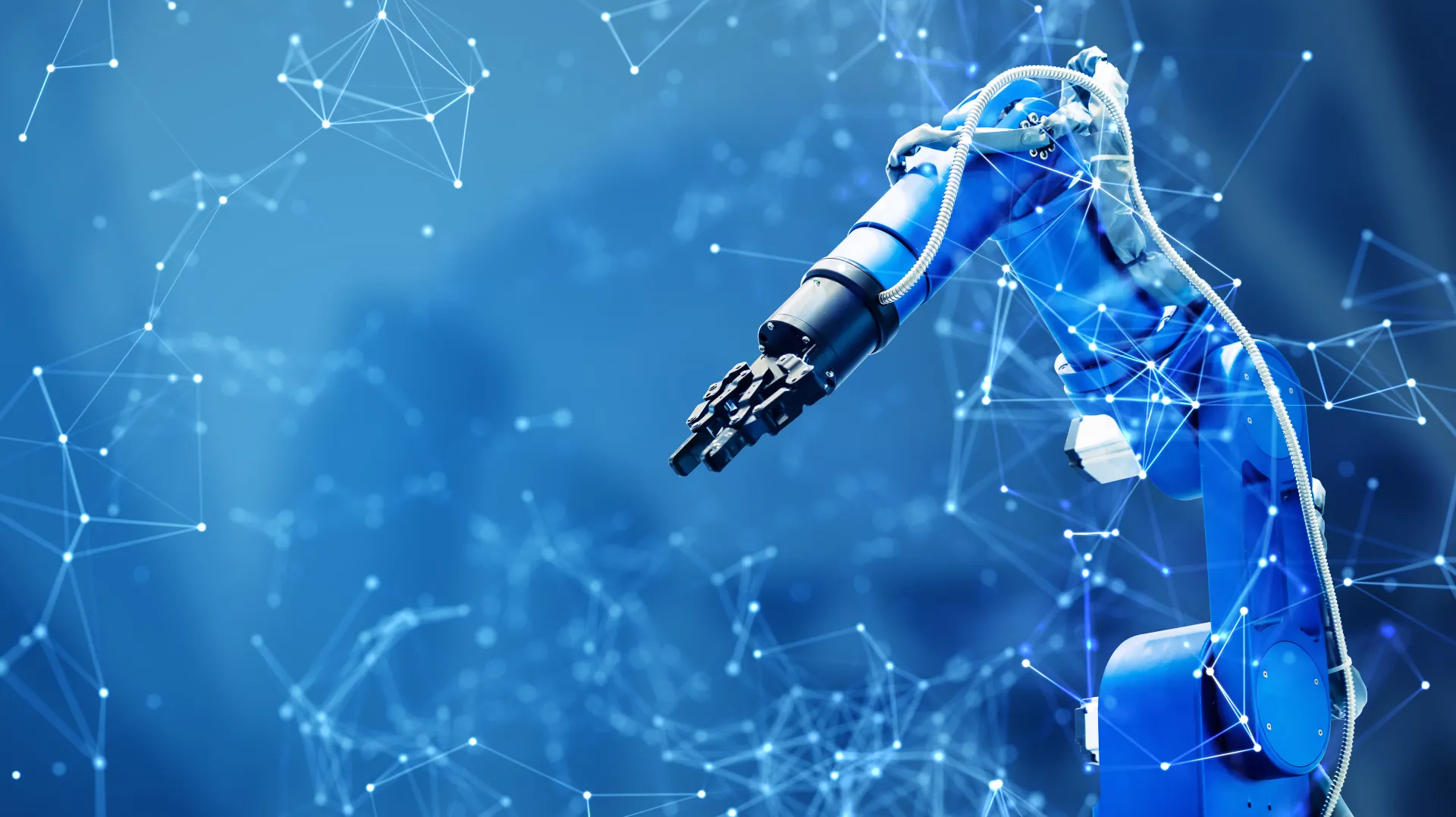A Robot Provider's Digital Journey: An Expert's Point of View
Let’s listen to Arvind Krishnan, industry analyst at Lifecycle Insights and Michael Mayr, Industrial Equipment sales strategy expert at Dassault Systèmes. They will discuss the robot industry and how startups can succeed in this market.
Designing Impactful Innovation podcast - episode 1
In this first episode, our guests provide an overview of the robotics industry and specifically the role of startups in the field. Tune in to find out more about the challenges startups face and how they use the 3DEXPERIENCE platform on the cloud to transform their ideas into products.
Meet our speakers


Develop innovative products in the robotics industry
The 3DEXPERIENCE platform on the cloud acts as a unified and collaborative solution where robotic providers can manage their end-to-end process in an effective way by bringing together all teams and disciplines involved and guarantee digital continuity during the entire product lifecycle.
You can follow the "Designing Impactful Innovation" podcast on Apple podcasts, Spotify, Deezer, YouTube or by RSS.
Stay tuned!
Read the transcript
Clara: Hello and welcome to the Designing Impactful Innovation podcast, where we explore the world of product design, simulation and manufacturing. In each episode, we’ll hear from experts and learn about how they are using the 3DEXPERIENCE platform on the cloud to innovate and create positive change.
Today we’re starting a two-episode series: From Design to Deployment: A Robot Provider's Digital Journey. In this first episode, we’ll be hearing from an expert in robotics, and in the next episode we’ll focus on sewts, a robotics startup in the textile handling sector.
Let’s listen to Arvind Krishnan, industry analyst at Lifecycle Insights and Michael Mayr, our Industrial Equipment Industry Sales Strategy Expert at Dassault Systèmes.
Michael Mayr: Yeah, of course. Thank you very much. Hello to everybody.
My name is Michael Mayr. I'm 54 years old and I'm a member of the Industrial Equipment Industry Division at Dassault Systèmes. As a director of Sales and Business Development, I’m responsible for the global IE Industry segment Robotics and Machining. Of course, the main focus is on robotics.
The last almost 25 years I was fascinated about the industrial automation industry and worked in different positions for key players there, so like in the automation fields of sensorics and safety for the company Leuze and in the robotics companies like the Japanese Scala and the German Kuka Company.
Finally, in mid-2019, I moved to Dassault Systèmes to drive the global business development of that huge growing robotics market.
Why growing? Just a point: as we all know, faced with more and more dramatic labor shortage, especially in Europe and Japan, but also seen coming in the Americas region and China, there was no other choice than to automate partly work/tasks which are manually done today. Yeah. So we are talking about the four “DS”s in the industry – in the robotics industry. Dirty, dangerous, demanding and dear (costly) jobs, also pressured painfully by supply chain issues. The last two years, based on the COVID-19 pandemic, the re- and nearshoring in the US or Europe became an intensive discussion.
And a third interesting trend, I would say – ends in an Automation need – is based on the individualization megatrend to personalize consumer goods, which makes a highly flexible module-based, reconfigurable production necessary. So we call this the “flex factory of the future” within the industry 4.0, which is in the meantime well-known. The new robotics technologies are enabling factories to go – consequently – they have to go consequently that way now.
Arvind Krishnan: That was an impressive introduction, Michael. So, you know, you give us really the need for why the robotics industry is growing. Maybe if you can – for our audience – give a general overview of the industry as it stands today. Specifically, if you can talk about the role of startups in the robotic industry, that will be quite interesting.
Michael Mayr: Yeah, of course I can do this. So yeah, let's have – what is the basic situation, the robotics worldwide today. So I would say have a short look on to the IFR, the Industrial Federation of Robotics 2020 Report. There are some facts, I would say worth to name.
There were more than half a million robots installed in 2021. The existing stock of running robots worldwide is about 3.5 million robots in operation. This means about 7 to 8% annual growth for industrial robots for the next years. For that new collaborative, these flexible and economical robots are covering mainly handling tasks. We see – or the IFR sees – a growth of 20 to 30% is expected in the coming years. This means in revenue 1.2 billion U.S. dollars in 2021 to 10 billion U.S. dollars in 2027.
About the regions, Asia covers the main global share with about 74%, which is huge. China alone 51%. Europe covers 16% and the North American markets 10%. So traditional suppliers focused ‘til now on the industries where robotics started. This means automotive, this means fully automated body in white welding and painting shops.
The next industry was the electronics industry, mainly in Asia, to cover boring jobs done by tens of thousands of workers to improve quality mainly. Followed then by the metal machinery industry, for example: machine tending applications done by robots and now with the new robot technologies with self-training robots enabled by dramatic developments in artificial intelligence with specialized gripper technologies, with self-navigating mobile robots running on the production of warehouse floors to transport goods, and with a wide range of products and suppliers which are existing now and developed during the last five to seven years.
Just next, important industries are knocking now at the robotics door and these are also very, very interesting industries like logistics and fulfillment when it comes to e-commerce, retailing, consumer goods, but also agriculture, farming, life science, medical hospital or construction. As an example to give you, Amazon installed almost 500,000 mobile robots running in their distribution centers worldwide.
In that field, we are talking, by the way, about 40 to 60% annual growth. So which is very, very interesting. And what is the role now of these robotic start ups exploding? The last three years, I would say for me, there are two things important. First of all, they need to support all these traditional suppliers to cover the increasing industries hunger on robotics, automation. Both markets and existing players are highly interesting in these young tech enterprises and startup communities and clusters.
To give you an idea of what we are talking about here: in 2021, more than 17 billion U.S. dollars spent by venture capital tech investments tripled in investment in 2020. Last year is behind that crazy number, but it has also seen more than 5 billion flow to startups.
The second point is the specific task for the startups to stronger investigate/develop on advanced robotics – means mainly how to make the robots really clever to open new fields by solving so many of the tasks in niche markets. For instance, to guarantee a higher automation degree as the basis demand to bring production back home like the textiles industries from Bangladesh or China. If, for example, a startup from a former colleague of mine, Michael Fraede…company’s startup name is robotextile, its robot cells take over the automated destacking of textile fabric layers for sewing pants economically and safely. So it is very interesting, very new interesting fields.
Arvind Krishnan: Oh, interesting, interesting Michael indeed. You know traditionally we've been really thinking of robots being very active in automotive industries, things that generally people assume that robots do well like welding, painting, etc… But it's really interesting to know how they have expanded way beyond that traditional automotive and now towards even textile. That was interesting.
And the second point you made is about the amount of money venture capitalists are willing to spend in this particular industry. That kind of tells you how the growth is. So that's $17 billion in 2021. That really sums it up nicely. And 2022 wasn't as bad. It wasn't as good, but it wasn't bad either, considering that there's been a significant slowdown in the markets.
Michael Mayr: Yep.
Arvind Krishnan: Very interesting perspective Michael. Very interesting. You know, we will delve a little bit into the startups. You know, it's very interesting that these startups are there in the robotics industry. They have clever ideas. You mentioned robotextiles, a company that you probably know a little bit better, and they are very eager to commoditize or productize their new ideas. I mean, but it does not sound as easy. Am I correct?
Michael Mayr: Yeah, I mean, I would say nothing is easier, so you cannot sell just the idea. Investors want to see – investors of the startups – they want to see the proof of your idea, of the technology and the product in real operation at the end. This also point that young tech startups are mainly struggling when just focusing on this interesting technology, but do not see that they have to sell at the end the final product. And from these investors normally you get a time of about 1.5 years, probably two years.
So really different to the past, by the way, and dealing today with these highly dynamic markets. And just to focus on interesting and cool technology is not enough. There should be a clear focus on market segment and the potential of the market and where it is and the pilot customer. All should exist close to your office, by the way. Faced with these concrete challenges, this means for me when it comes to development: you need to find an office. You need to find rooms, get the IT infrastructure, the engineering and simulation testing tools, the hardware, and of course, find the resources for the software development, for the hardware development, for the electrical development and for the testing engineering; and bring it all together, no matter where they are based. Save your R&D budget, save hardware test prototypes, save time.
How to involve pilot customers to get the important tech feedback from them early enough… these are all questions you are faced for the development when it comes to precise activities also, lots of challenges. You need to start early enough. Your market should be prepared before producing the first batches.
And then how to create the marketing material, how to show the idea to customers and communicate with STEM in parallel to the ongoing development faced with permanent changes.
The next challenge when it comes to production – and this is combined with high invest – find partners for first productions close to your startup’s location – will be good. Where should the production site be for series production then and how to set it up? How to communicate with them and control them? How to make the best quality sure? And find the right and experienced, well-skilled resources here.
And then when it comes to aftersales and service, are you able to offer this to end users, for example, which are running your innovation, your solution in their production site 24/7? How to find the skilled technicians? How to clarify the service stock, the spare parts and at the end – which is maybe more important for your development and for the startup as a company – get the data feedback for the product improvements.
So these are lots of challenges, I'm sure not the end. So we – they – are faced with some more challenges. But yeah, of course it is not that easy.
Arvind Krishnan: Okay, so clearly you mentioned that, you know, robotics startups, it's not extremely easy for them to scale and become successful. And you also kind of enumerated all the challenges that first come with the development of the product. Ideas into products mean two different things. Thanks for bringing that up.
But a successful company needs to worry about sales, production, after sales support service, etc. I think they were very valuable points: that most startups might have trouble getting on with, right? But having all these disadvantages and challenges that startups are navigating. But I still feel that startups have some inherent advantages over the incumbent challenges in this market. One thing I can think about is really the flexibility with which startups are able to embrace you know, technology, even though some of those technologies may not be a perfect solution, but they probably help startups compete well with incumbents. I would love to hear your thoughts on this.
Michael Mayr: Yeah, of course. So basically I fully agree, Arvind, with what you said. Yeah. To answer this, let me try in that way, not only to embrace new technologies by startups – I mean this is what the market actually is expecting from the tech startups – but to be flexible, open for new ways and willing to work intensively together with pilot customers. To really understand that this application problem in the production and at which final targets they have to meet – the customers have to meet – this is easier for startups. They have the – well, let's say – the right, or the strong ear to the customer. What a clever guy in the past said, what's really interesting for me or helpful, or important: always, always close the loop with your customers. Ultimately, it's their opinions that matter.
So let's say startups are working differently to traditional suppliers and big enterprises, by a different spirit. And probably this is – I would say this is – one of these advantages they have. They are focusing just on one clever idea to solve one problem. They have no thousand discussions with management, struggling with R&D on resources planning; no persuasion fights with sales and production management on portfolio planning, or maybe faced with a basic blockage by the elder staff – what we all painfully know from an established big enterprise (“We have done it in that way very well the last 20 years.”).
So I would say it is, at the end, a new channel by the startups to open eyes to try and test what is possible, to drive things established players being shy of taking the risk limited by their organizational constraints, I would say.
Arvind Krishnan: Thank you, Michael. Yeah, if you're a listener who is a robotics startup, I'm sure you can resonate well with the points that Michael just brought out. That's really your raison d'être to actually be that. So that was well articulated Michael. So let's now jump to something that is probably more dear to your heart.
So it's well known that startups must compete with the established companies to succeed. That's, that's a given, right? But let me come to: what can the 3DEXPERIENCE platform and Dassault Systèmes offer startups? In your capacity as someone leading the sales effort for Dassault Systèmes in the robotic startups, can you tell us: if I'm a startup owner, can you tell me how your company, Dassault Systèmes, can actually help us in the early stages so that the probability of the startup success is high?
Michael Mayr: Okay, fine. Yeah. So when it comes to competing with “the incumbents”, the established players, then we are talking directly about what we can do as Dassault Systèmes for them: how we can help startups to ease their start or I would say better to guide their work on all processes of the whole product lifecycle, of their innovation, of their product idea and solution.
My recommendation to startups – and also then I will support, you know, our offer here – is first of all focus – as I said before – to be, from the start of development ‘til the delivery of the product and during operations afterwards, very close to the customer and close to your suppliers. This means try to be permanently connected to them and offer them a way to directly collaborate with you as the solution supplier.
Create your ecosystem as a startup, of pilot customers, suppliers, production partners, sales partners, based on one digital collaboration platform. We call it the one digital single source of truth on one database. Everybody connected is able to take part and collaborate with you because you’ll really be able to speed up. And this is one of the benefits against the incumbents, when getting immediately the response from the stakeholders: that the solution finally fits 100% to the customer’s need.
Yes, I mean, I our 3DEXPERIENCE platform is a business experience platform that integrates the 3D design, simulation and information intelligence software in a collaborative virtual environment, enabling every organization in the company to support the value creation process. This is a way to bring all enterprise units together and save all information and data on one digital backbone and to be able to work on one data model.
We are talking here about the digital continuity of all processes. The 3DEXPERIENCE on the cloud offers a way to project stakeholders to interact digitally, from the designer and engineer via marketing and production to the suppliers and the end users. It offers a complete digital infrastructure for all process disciplines equipped with the most important tools and apps you need.
And this means for the start ups – and this is all – this is the benefit – you have a chance to start as a digital enterprise from the beginning.
Another point or another recommendation from my side is focus on your product innovation and prevent wasting time and money on setting up your IT infrastructure and organizing IT resources, which is highly complicated I would say.
Saying this, the 3DEXPERIENCE platform on the cloud is a flexible, scalable solution which gives you, the startup, not only the agility and flexibility to expand its computing resources based on its demands to work, always based on the newest apps and tools updates without IT and security effort; it’s also a future-proven solution able to grow fast with the startup – with you – also by expanding business into new markets, by setting up, for example, global production sites or global development teams or sales and service teams and offices. So it means connect the dots by the 3DEXPERIENCE platform.
Another point is another recommendation: focus on improving the multidisciplinary work together. This means for mechanical development, for electronic development, for software development, for the service department, for the manufacturing engineering within the company. The 3DEXPERIENCE allows you to do it in real time for all processes, end to end and accelerates herewith dramatically your innovation, your product development. Benefit for the startups: there are no existing silos like we see it usually in the bigger enterprises.
And a last point is: focus on reducing resources and money for hardware test in each development test. Work, test and simulate based on a virtual twin of the product the requirements, traceability of the system, the design engineering; the virtual twin of the machine application, the virtual twin of a production line.
By help of that virtual twin you can move tests analysis into the virtual world, fully free to modify change and prototypes can be reduced onto a minimum at the end. The product will be digitally tested and failures can be simulated and analyzed in real time. So this is what I would say is important for me when it comes to a startup. And so these are solutions or this is – let's say – our offer to these startups.
Arvind Krishnan: Yeah, excellent point Michael, excellent. If I just summarize a few things that keep my ears, if I must say, is first – as being, you know from day one – you can actually be a digital enterprise throughout your life cycle, the 3DEXPERIENCE offers that.
You also mentioned how IT resources – startups, startup leaders, don't want to spend a lot of money, effort and time on IT infrastructure. Suddenly easing that is a big, big advantage for startups.
So also the ability to do multidisciplinary work together. You know, we all know that the robotics – the whole idea of conceiving and then bringing a product to the market is not just one discipline. And the ability to work, for all disciplines to work on one platform was indeed interesting.
And finally, you mentioned the virtual twin, or the others in the industry might know it as digital twin and the ability to start with the digital twin (or a virtual twin) right from day one presents some very interesting advantages. So this concludes our podcast for today. I want to thank Michael for your valuable insights.
Michael Mayr: And you're welcome. Yeah, it's a real pleasure for me Arvind.
Arvind: Thank you.
Clara: Thank you for listening to Designing Impactful Innovation. Stay tuned for the next episode where we’ll be talking to Tim Doerks, CTO and co-founder of sewts, a robotics startup specialized in automated textile handling. To find out more, go to 3ds.com/cloud. Don’t forget to subscribe for more insights and stories from our guest experts!
Learn more
Ready to learn more?
See how the 3DEXPERIENCE platform on the cloud can transform the way you design and produce your robots.





